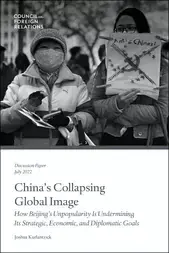Belt and Road Initiative
The Belt and Road Initiative poses a significant challenge to U.S. economic, political, climate change, security, and global health interests.
Mar 23, 2021
The Belt and Road Initiative poses a significant challenge to U.S. economic, political, climate change, security, and global health interests.
Mar 23, 2021
-
What Is ASEAN?The Association of Southeast Asian Nations is a regional organization that brings together disparate neighbors to address economic and security issues, but the group’s impact remains limited.
-
Why Is China Investing In a $1.7 Billion Canal in Cambodia?The Funan Techo Canal is the latest in a string of flashy Chinese investments in Cambodia. How did Cambodia, a lower-middle-income nation of 17.5 million people, become a focal point of Chinese foreign policy and investment?
-
Tracking China’s Control of Overseas PortsThis interactive map tracks China’s growing maritime influence through investments in strategic overseas ports. Users can plot the location of each port and view satellite images alongside detailed information on the share of Chinese ownership, the total amount of Chinese investment, and the port’s suitability for use by the Chinese military.
-
China and India Compete for Leadership of the Global SouthChina and India compete for leadership of the Global South, but it remains unclear whether either is winning.
-
How One Port’s Struggle Reveals the Problems—and Promise—of Chinese Infrastructure FinancingChinese port financing has plenty of drawbacks. But developing countries have few alternatives.
-
China’s Belt and Road Initiative Enters Its Second Decade: Which Leaders Went to Beijing to Celebrate with Xi Jinping?High-level attendance at this year’s Belt and Road forum is down, but BRI still has support in the Global South and will be used by Beijing to strengthen the Global South as a counterweight to the U.S.-led international order.
-
Will the U.S. Plan to Counter China’s Belt and Road Initiative Work?At the G20 summit, the United States and its partners revealed an economic corridor linking India, the Middle East, and Europe. It is premature, however, to call this a serious counterweight to China’s Belt and Road Initiative.
-
Why Is Italy Withdrawing From China’s Belt and Road Initiative?Italy’s withdrawal from the Belt and Road Initiative would reflect disappointment with the lack of economic benefits and a more fundamental strategic rethinking of China.
-
CFR Fellows' Book Launch Series: Sovereign Funds: How the Communist Party of China Finances Its Global Ambitions by Zongyuan Zoe LiuOne of the keys to China’s global rise has been its strategy of deploying sovereign wealth on behalf of state power. Since President Xi Jinping took office in 2013, China has doubled down on financial statecraft, making shrewd investments with the sovereign funds it has built up by leveraging its foreign exchange reserves. Sovereign Funds tells the story of how the Communist Party of China became a global financier of surpassing ambition. In Sovereign Funds, Zongyuan Zoe Liu offers the first in-depth account of the evolution of China’s sovereign funds, and shows how these institutions have become mechanisms not only for transforming low-reward foreign exchange reserves into investment capital but also for power projection. The CFR Fellows’ Book Launch series highlights new books by CFR fellows.
-
The Rise and Fall of the BRIAmidst accusations of “debt-trap diplomacy,” Chinese companies seek more overseas direct investment opportunities and fewer foreign contracted projects as Xi’s flagship initiative is stymied by poor risk management.
-
China’s Massive Belt and Road InitiativeChina’s colossal infrastructure investments may usher in a new era of trade and growth for economies in Asia and beyond. But skeptics worry that China is laying a debt trap for borrowing governments.
-
EU Outrage Clouds Hamburg Port DealDespite controversy surrounding the deal, the approval of a Chinese stake in Europe’s third largest port may be a smarter decision than it initially appears.
-
China’s Collapsing Global Image
![]() China’s global image has deteriorated significantly in the past four years, alienating leading democracies and developing countries alike with aggressive foreign policy, economic coercion, and faltering soft power policies.
China’s global image has deteriorated significantly in the past four years, alienating leading democracies and developing countries alike with aggressive foreign policy, economic coercion, and faltering soft power policies. -
Recipient Countries Hold the Key to China’s BRI SuccessBRI should not simply be assessed by looking at China’s interests. Recipient countries matter because their geopolitical concerns and domestic interests can intersect to affect how well BRI functions.
 Online Store
Online Store
